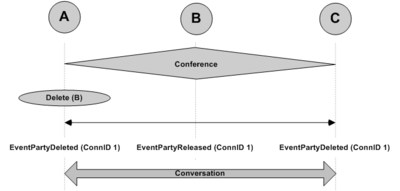Contents
Releasing Calls
This section illustrates the standard processes by which calls are released.
Note the following comments in the call models:
*OPT—Optional.
*DIAL—May be a dialed number or is not present if T-Server has no information about the other party.
Release Phase
The following graphic and table describe the release phase.
| PARTY A | PARTY B |
|---|---|
|
Conversation | |
| Release (TReleaseCall) | |
| EventReleased ConnID 1 |
EventReleased ConnID 1 |
Release from Conference Phase
The following graphic and table describe the release from conference phase.
| PARTY A | PARTY B | PARTY C |
|---|---|---|
|
Conference | ||
| Release (TReleaseCall) | ||
| EventPartyDeleted ConnID 1 |
EventReleased ConnID 1 |
EventPartyDeleted ConnID 1 |
|
Conversation | ||
a. If more than two parties remain in the conference call, CallState has a value of Conferenced; otherwise, CallState has a value of OK.
Delete from Conference Phase
The following graphic and table describe the release phase.
| PARTY A | PARTY B | PARTY C |
|---|---|---|
|
Conference | ||
| Delete B (TDeleteFromConference) | ||
| EventPartyDeleted ConnID 1 |
EventReleased ConnID 1 |
EventPartyDeleted ConnID 1 |
|
Conversation | ||
a. If more than two parties remain in the conference call, CallState has a value of Conferenced; otherwise, CallState has a value of OK.



